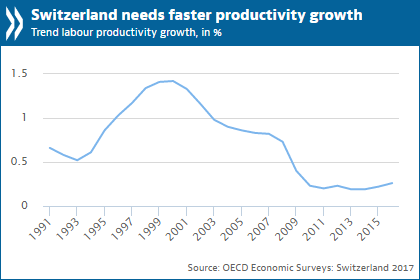Switzerland: Sustain high levels of well-being by boosting productivity growth
The Swiss economy has shown considerable resilience to shocks, but economic growth remains slow, and per capita income levels still hover at levels attained before the global economic crisis. Further reforms are needed to restore productivity growth, boost incomes and ensure that the high living standards and levels of well-being are passed on to future generations, according to a new report from the OECD.

The latest OECD Economic Survey of Switzerland points out the limited scope for further use of unconventional monetary policy to support the Swiss economy. The Survey projects growth of 1.7 percent in 2018 and 1.8 percent in 2019. It lays out a range of policy options that could help Switzerland boost productivity, maintain its high-skilled workforce and manage the challenges posed by population ageing.
The Survey was presented in Bern by Alvaro Pereira, director of the country studies branch in the OECD Economics Department, Swiss State Secretary Marie-Gabrielle Ineichen-Fleisch and Eric Scheidegger, head of the economic policy directorate of the State Secretariat for Economic Affairs (SECO). It identifies priority areas for future action, including reforms to further bolster economic growth, maintain stable pension systems, enhance competition, raise labour market participation and improve already well-regarded education and training systems for future generations.
The Survey says that stronger economic recovery and future income gains will hinge on continuation of sound fiscal policy and healthy financial markets. To support growth, the Survey suggests Switzerland avoid persistent budgetary under-spending through better coordination at federal and sub-national levels. Reducing agricultural subsidies and pursuing more efficient public spending would free up funds for measures to boost growth and inclusiveness.
To reduce risks, the Survey says Switzerland could eliminate the remaining explicit cantonal government guarantees to public banks and establish a formal framework for setting mortgage lending limits, taking affordability into account and ensuring enforcement on a comply-or-explain basis.
To address ageing-related challenges, the Survey recommends Switzerland fix the retirement age at 65 for all workers, and thereafter link it to life expectancy. Increased financial incentives to work longer before retirement and promotion of programmes to lengthen healthy working lives, including preventative health programmes, are also recommended. Life-long training, career planning and tailored job-search assistance would enhance workers’ resilience to market-induced changes.
To boost productivity for long-term growth, the Survey calls for increased private ownership and the removal of barriers to entry, including restrictions on the number of competitors, in the energy, telecommunications and transport sectors. Improving competition, raising trade in services and investment and lowering administrative burdens could also help boost the creation of innovative start-ups and revive growth. Raising the number of innovative start-ups could also reverse divergence between so-called frontier firms at the high end of the productivity spectrum and the rest.
The Survey points out that some parts of the population, notably women and immigrants, are not achieving their full potential in the labour market. Increasing the affordability of childcare, shifting income taxation to individual rather than household incomes, and facilitating high-skilled immigration from non-EU countries would help meet future labour market needs.
Continued economic prosperity will require a growing supply of a high-skilled workforce. The changing nature of work will call for a nimble, dynamic and inclusive skills-training and life-long learning system. Government policy can encourage greater participation of small firms in apprenticeship systems and better linkages between the school-based vocational education and training system and employer associations. Subsidies can be used to encourage participation in continuing education and training for groups with low participation rates.
Source: Organization for Economic Co-operation and Development
- 231 reads
Human Rights
Ringing FOWPAL’s Peace Bell for the World:Nobel Peace Prize Laureates’ Visions and Actions

Protecting the World’s Cultural Diversity for a Sustainable Future

The Peace Bell Resonates at the 27th Eurasian Economic Summit

Declaration of World Day of the Power of Hope Endorsed by People in 158 Nations

Puppet Show I International Friendship Day 2020

